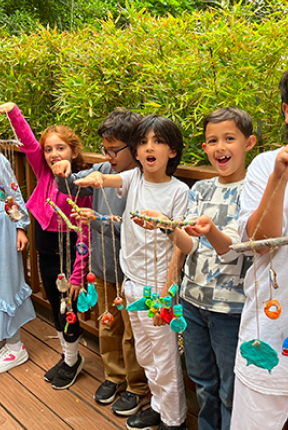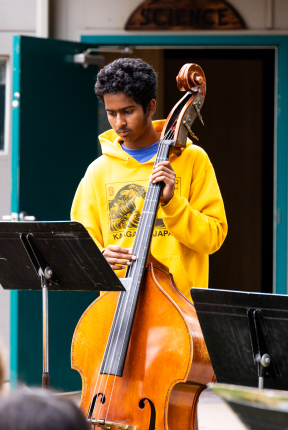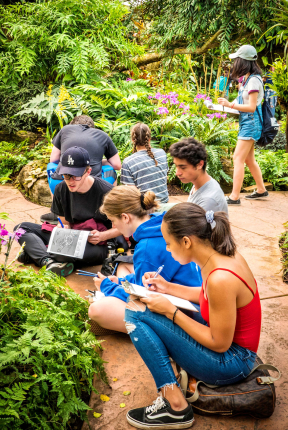Mona Lewis, Highland Hall Handwork Teacher, writes about her work with natural dyes and the benefits it offers to students.
An article by Mona Lewis, Handwork Teacher
As an artist and an educator, I have been very fortunate to find a place that supports both my passions. For many years I have been a teacher at Highland Hall Waldorf School, where reverence for the child, and for all of nature, is built into every aspect of the curriculum. I was first introduced to natural dyes by my mentor, Alicia Dodge, a master dyer who teaches at the Santa Barbara Waldorf School and at Rudolf Steiner College in Sacramento. At first, it was the incredible beauty of natural colors that drew me to this medium. Later, the rich cultural traditions associated with each color, along with the invaluable educational experience for children, solidified my obsession.
At school, we dye a rainbow of colors for the students to knit with, using exclusively locally grown or foraged natural dyes. This is the palette of our time, and our place – unique in all the world!
To this end, several beds in our biodynamic farm are dedicated to dye plants. One bed is solely for amazing plants that were cultivated in medieval gardens, and cherished for the beautiful colors they gave. Our historical dye garden includes: Indigo for blue, Artichoke, Dyer’s Chamomile and Weld for yellow, Madder and Lady’s Bedstraw for red. There are also useful dye plants sprinkled throughout the garden as companions for the vegetables. These dye colors are supplemented with Eucalyptus leaves, Black Walnuts and Cochineal bugs, all foraged locally. Our rainbow of yarn colors shifts and changes according to the season, the weather, and interest of the gardeners. The fun of experimenting and searching for new dye colors is shared by teachers, parents and students. There have been some very interesting innovations, to say the least!
Students help with planting, tending, harvesting, and dyeing the yarn. Later they knit with the yarn they have helped to color. It’s a great moment when they start asking for a yarn by it’s plant name:
“Miss Lewis, do you have any of that Artichoke left?”
There is also a garden for fiber study. In that bed is heirloom cotton, flax and papyrus. Students work with each fiber personally, and learn how they are used. All these activities teach more love and respect for nature than I ever could using only words. Now that children are spending more time than ever, inside, in front of a screen, this kind of art making brings an opportunity to balance the child’s experience. Conversing with nature, co-creating with the plants inspires such a joy! It opens the door to a sense of wonder that is really nourishing and empowering.
At home, I love dyeing all kinds of natural fibers, and making my own clothes. Occasionally I take a commission for a dress or plant dyed shawl. Showing the beauty of natural colors is a responsibility I take seriously, because I think it opens minds and hearts to alternatives. The clothing industry is one of the most brutal in terms of the pollution caused by chemical processing. There are some stores I just can’t go into anymore, because I know what those colors did to a river somewhere. Plus, it’s amazing to wear something steeped in the magic of local color. The smell, the feel, and the special qualities of each plant color, serve as reminders that we live in a world which is anything but mundane.
I read once that every medieval cottage had a pot of weld growing by the back door, and, that fermented vats of Indigo have been tended for 100 years in the same home, in Japan. I can imagine a world where this is normal again. Each location having it’s own unique palette, each artist having their unique sensibilities and connection to the plants. Awareness for sustainability would be natural. Synergetic method sharing could be the norm, as it is now, in a growing community of environmentally conscious artists. In so many ways, it is an honor to be a part of this work.
Connect with Mona Lewis via her Facebook Page






